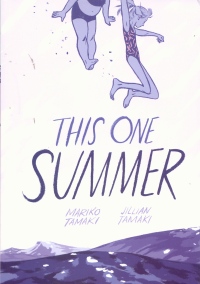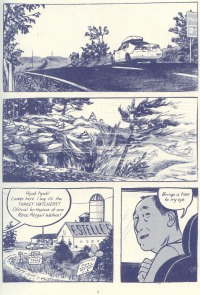| ________________
CM . . .
. Volume XX Number 39. . . .June 6, 2014
excerpt:
Mariko and Jillian Tamaki have once again produced a gorgeous and engrossing book in This One Summer. The cousins’ second graphic novel together features their hallmark beautiful illustrations and lively dialogue. The story is about two girls on their annual summer holiday in a small beachside Canadian town. Rose’s parents are struggling in their relationship, and Rose is beginning to negotiate early adolescence. Windy is a younger girl who is staying down the road from Rose’s family. Rose says, “Windy has been my summer cottage friend since I was five” (p. 19). The novel is a meditative portrait of their lives over this one summer.
The characters and their relationships with one another are believable and intriguing. Although Rose is the narrator of the story, there is little direct narration. The reader must infer developments from the discussion and actions of the characters. Mariko Tamaki’s dialogue is spot-on. She cleverly captures the tone and vocabulary of different groups of people. I particularly enjoy her use of intonation. For example, a teenage girl says to Rose, “Could you tell [your mom], um, that the girl? Jenny? That’s her name? Anyway, Jenny says ‘Thank you’? Just tell her Jenny is cool now” (p. 309). The thoughtful details of vocabulary and pacing make This One Summer an engrossing read. Jillian Tamaki’s illustrations are, as always, amazing. The illustrations use charcoal, pencil and wash in dark blues, black and greys to create a fully realised fictional world. Her strong and subtle use of line is particularly evocative of movement and emotion. I enjoy the way she switches between very realistic scenes, such as a lovely wordless three panel beach scene which shows every detail of the swimmers and the sea (pp. 138-139), and more cartoonish action scenes, such as the illustration of Windy dancing around Rose (pp. 70-71). The novel does not experiment much with the graphic novel form. In general, the pictures and the words have a fairly straightforward relationship. This unobtrusive style allows the reader to focus on emotion, characterisation and dialogue. The few scenes which do experiment with the graphic novel form tend to be illustrations of the sea in which characters dissolve and reappear and time shifts. I found the tension between the maturity of the two girls compelling. Windy is a year and a half younger than Rose, and, while she’s interested in talking about sex and fascinated by horror movies, she is more child-like than Rose in many ways. Windy is comfortable dancing, making sand castles and hanging out with her grandmother. Rose, on the other hand, sits hunched up, mocks Windy when she dances, and says things such as “FINE. Yes. God” when she talks to her parents (p. 267). One of my favourite scenes that demonstrates this age difference is when the girls are visiting the Historic Heritage Huron Village. Rose thinks the village is “so dumb” and refuses to participate in any activities (p. 210). Windy suggests that they make a basket, saying, “It would be nice to maybe . . . do something” (p. 210). Rose is exploring the tedium of adolescence while Windy still wants to play. I appreciate the way the novel is quietly body positive (Windy is a plump girl who obviously enjoys her body) and queer positive (Windy and Rose agree that, if you are a lesbian, that’s cool). I also like the way that the novel portrays many different kinds of loving relationships. Rose has a playful and caring relationship with her father, Windy has a loving (if prickly) relationship with her adopted mother, and both girls easily fold into the other’s family for days at a time. Even though the themes of the text focus on reproductive sex, the novel shows that people of different ages and genders can love and care for each other in many different ways. It is hard to suggest an audience for This One Summer. Although there’s no physical contact more graphic than kissing, sex is a frequent topic of discussion, and, true to Mariko Tamaki’s ear for language, characters sometimes swear. However, there’s nothing in this novel that any child who watches television hasn’t heard before. Most tweens would be familiar with (and probably have participated in) the kind of sex talk that happens in the book. Also, as Windy’s mother says about Rose’s mother’s miscarriage: “You should tell her. Kids are . . . they get it” (p. 301). Ultimately, this book is best suited for people who are trying to navigate the beginnings of adolescence as it captures the sort of in-between state of puberty. However, older teenagers and adults could also enjoy the book for a reminder of the confusions and pleasures of being stuck between childhood and adolescence, and for the way the novel offers a window into life in a small town. The illustrations, dialogue and characterisation are also enjoyable regardless of age. I recommend this book strongly. Highly Recommended. Lian Beveridge is an independent scholar based in Vancouver, BC. Her primary research interests are children’s literature (especially picturebooks) and queer theory.
To comment
on this title or this review, send mail to cm@umanitoba.ca.
Copyright © the Manitoba Library Association. Reproduction for personal
use is permitted only if this copyright notice is maintained. Any
other reproduction is prohibited without permission.
NEXT REVIEW |
TABLE OF CONTENTS FOR THIS ISSUE
- June 6, 2014.
AUTHORS |
TITLES |
MEDIA REVIEWS |
PROFILES |
BACK ISSUES |
SEARCH |
CMARCHIVE |
HOME |

 Themes of bodies and sex run through the novel. The girls joke about growing “giganormous boobs” (p. 305), and they share their somewhat spotty knowledge about sex: Windy thinks it is “so GROSS!”, but Rose knows that “you don’t have to do it if you don’t want to” (p. 63). Twin plots about pregnancy run through the novel. Rose’s mother miscarried an early pregnancy last summer when they were at the beach; this summer, Rose is fascinated by the unplanned pregnancy of Jenny, a local teen. At the end, the two plots tie together when Rose’s mother rescues Jenny from drowning.
Themes of bodies and sex run through the novel. The girls joke about growing “giganormous boobs” (p. 305), and they share their somewhat spotty knowledge about sex: Windy thinks it is “so GROSS!”, but Rose knows that “you don’t have to do it if you don’t want to” (p. 63). Twin plots about pregnancy run through the novel. Rose’s mother miscarried an early pregnancy last summer when they were at the beach; this summer, Rose is fascinated by the unplanned pregnancy of Jenny, a local teen. At the end, the two plots tie together when Rose’s mother rescues Jenny from drowning.